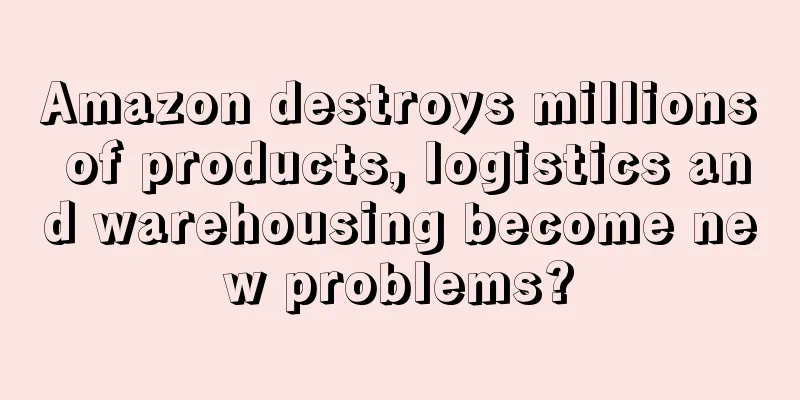Amazon destroys millions of products, logistics and warehousing become new problems?

|
On June 21, British media reported that Amazon destroys 130,000 products every week at its Dunfermline warehouse in Scotland.
Every year, Amazon destroys millions of items of inventory, including expensive items such as Dyson fans, MacBooks and iPads, and even more than 20,000 fully packaged masks.
An internal memo showed that in one week in April, 124,000 items were marked for destruction, while 28,000 products were marked for donation in the same week.
Most of these products were unsold or returned by customers, and almost all of them were in good working order, but they were thrown into giant dumpsters by Amazon, which are then trucked away and dumped at recycling centers and landfills.
Many people expressed their incomprehension about this:
Why are so many products destroyed so carelessly? This is not environmentally friendly. Capitalism is about profit, not waste.
Some people even associated it with the "sheep eating people" in the British "Utopia" and the dumping of milk during the Great Depression in the United States. They did not quite understand Amazon's move and even condemned it.
Amazon responded to the report by saying it was working towards a goal of zero disposal of its products, with its priority being to resell, donate to charity or recycle any unsold products. In the UK, no items are sent to landfill and as a last resort Amazon sends items to energy recovery but is working towards reducing this to zero. However, after carefully analyzing this incident, we will find that the root cause is its unique business model. However, for cross-border e-commerce, logistics and warehousing may become new problems.
01
Why destroy?
Let me give you an example. We all buy clothes in our daily lives. Sometimes after buying them, we only wear them once or twice and never wear them again. At this time, we can’t bear to throw them away, so we use a big box to pack the clothes that we think we don’t wear often.
However, once they are packed up, because they are inconvenient to take out, these clothes will eventually have only one fate: to be thrown away after taking up valuable space in the home for a few years.
Because the storage is done at home and the space is small, the cost is very low, but for Amazon, every square meter of space has a certain cost.
Amazon has a world-recognized first-class operating network, responsible for the receipt, warehousing, inventory management, order delivery, allocation and delivery, customer returns, returns to the factory, etc. of global manufacturers.
Under the FBA business model, sellers need to transport the goods to Amazon warehouses in advance, and then Amazon is responsible for delivering them from the warehouse to the buyer after the order is sold.
The advantage of this business model is that it not only improves the buyer's shopping experience, but also greatly improves logistics efficiency and speed.
Moreover, FBA not only provides fast delivery, but also helps sellers handle some after-sales services. Basically, sellers can concentrate on operations and do not need to solve some after-sales problems.
Therefore, many large suppliers are very happy to choose to place their products in Amazon's huge warehouses and only need to pay part of the storage fees and commissions.
However, everything has its pros and cons.
The FBA model does greatly reduce transportation and warehousing costs, but it also causes a lot of backlogs of goods. For unsold products, the longer they are stored, the more storage fees they will be charged.
If the huge amount of inventory is stored in Amazon's warehouse for a long time, it will not only waste storage space, but will also inevitably affect Amazon's normal turnover rate.
Destruction is undoubtedly the lowest cost and fastest solution.
02
Is self-built warehousing an advantage or a disadvantage?
In the field of cross-border e-commerce, all merchants cannot avoid two major problems: logistics and warehousing.
After the epidemic, international shipping costs continued to increase. On June 1, 2021, the average shipping cost of Amazon's own logistics was raised to 2-3%. The reason for the increase was the increase in costs.
In 2020 , Amazon expanded its warehouse space across its entire delivery and logistics network by 50% and incurred more than $5 billion in COVID-19-related costs.
In the first half of 2021 , Amazon still had billions of dollars in cost increases.
According to Shopify statistics, the retail rates of third-party logistics services USPS, UPS and DHL increased by an average of 4.9%, and Canada Post's domestic rates increased by an average of 3.9%.
The increase in transportation costs will further squeeze sellers' profits, so as early as 2014, Anker and SHEIN began to build and rent warehouses in North America and Europe.
Indeed, for some large sellers and enterprises, self-operated warehousing can reduce freight costs and save transit and warehousing costs once and for all, and can also improve customers' purchasing experience on the other hand.
However, for the vast majority of small and medium-sized businesses, the cost of building a warehouse is too high, and even renting a warehouse is completely unnecessary. Self-operated warehousing will not only consume a lot of manpower and material resources, but once the market is affected, a large amount of inventory will accumulate.
Therefore, if you don’t have a sales volume of tens of billions, don’t even consider the self-operated warehousing model. It will only do more harm than good to small and medium-sized sellers.
03
How to solve new problems?
Every year, millions of tons of inventory are cleared out as "junk". Even a large platform like Amazon is troubled by inventory problems.
Then for ordinary sellers, inventory issues must be extremely important.
First of all, before launching the product, we must do sufficient market research and prospect forecasting to avoid fighting an unprepared battle.
Because they chose the FBA model, once the products are unsalable, they will face financial losses. Once these goods leave the ports of China, no matter how the sales volume is, they will basically not be brought back.
Secondly, for products that have been online for three or four months but have slow sales, the best option is to clear the inventory as soon as possible, whether it is an official Outlet Deal or off-site promotion method such as the Amazon Promotion Alliance.
Maintaining a healthy and benign inventory turnover rate is the key. Only by accelerating inventory turnover can we increase the recovery and utilization of funds, reduce inventory backlog costs, and ensure sufficient funds to adapt to market changes.
Furthermore, we must decisively cut off some useless production lines.
If these useless product lines are not cut off, they will only continue to put pressure on the company's cash flow. By constantly sucking blood, even good products will eventually be dragged down by cash flow.
For the Amazon industry, the more SKUs there are, it does not necessarily mean that the more products will be sold and the better the sales volume will be.
For some small and medium-sized sellers, the more streamlined the SKU and the shorter the product line, the longer they will survive.
Finally, from this incident, we can see that the reason why Amazon encountered such an incident is entirely due to its huge supplier base and its own business model.
Through this business model, Amazon has become the world's largest e-commerce platform and has gained huge commercial value, but there are also many problems. Therefore, it is also necessary to handle inventory management, reduce its own turnover rate, and reasonably handle warehousing problems.
Nowadays, even the leading platforms are like this. For ordinary sellers of all sizes, the issues of logistics and warehousing are even more urgent. Amazon Amazon logistics |
>>: The opportunity is here? Amazon Chinese sellers are favored by multinational capital
Recommend
Australian food company Maggie Beer acquires e-commerce gift basket business
Australian food company Maggie Beer acquires e-co...
What is RepricerExpress
RepricerExpress is a fast, powerful Amazon and eB...
What is ohyeahqueen? ohyeahqueen Review, Features
ohyeahqueen is an international B2C fast fashion e...
What is $10 and under? $10 and under Review, Features
Amazon launched the "Free Shipping for Order...
45% of the top sellers are located in China, and the number of Chinese-made products on Amazon has soared
The number of Chinese sellers on Amazon has been ...
What is gallery-lin-song-ge? gallery-lin-song-ge Review, Features
gallery-lin-song-ge specializes in the finest orie...
Taobao’s notice to online shoppers: If you watch CCTV Spring Festival Gala and browse Taobao, 40,000 shopping carts will be emptied!
This year, Taobao will be on CCTV Spring Festival...
What is Spark Pay? Spark Pay Review, Features
Spark Pay is Spark's mobile payment product, p...
Check it out! Many sellers received a refund from Amazon
Starting this week, Amazon has implemented a numb...
What is Wanhong Network? Wanhong Network Review, Features
Shenzhen Wanhong Network Service Co., Ltd. is a n...
What is L Brands Group? L Brands Group Review, Features
<span data-docs-delta="[[20,{"gallery"...
What is VAT
VAT (Value-added Tax), originated in France, is a ...
Securities research reports are optimistic about Alibaba International Station, and new energy, machinery, auto parts and other advantageous industries have broad prospects
On May 31, China Merchants Securities released a ...
What is China-Europe Railway Transport? China-Europe Railway Transport Review, Features
China Railway (China Railway Logistics Co., Ltd.) ...
What is ChannelPilot? ChannelPilot Review, Features
<span data-docs-delta="[[20,{"gallery"...









